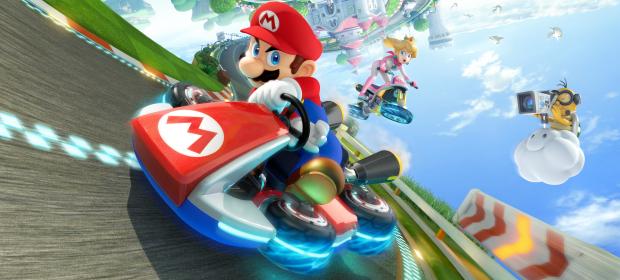There are a plethora of highly anticipated releases coming in 2014, but in terms of one game’s significance to the industry, you can be sure that there isn’t a more important title this year than Mario Kart 8.
While many gamers may roll their eyes at the cutesy kart racer, its easy to forget that Nintendo’s last console Mario Kart was a genuine phenomenon. Mario Kart Wii managed to shift more than 35 million copies – beating even GTA V’s impressive numbers and making the plumber’s racer the fifth bestselling game of all time.
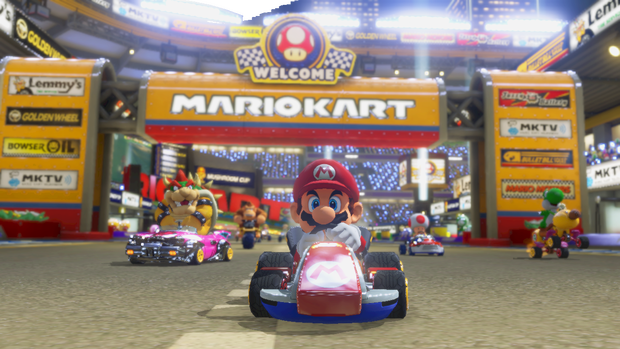
If any console is in desperate need of a bestselling sequel right now, it’s Nintendo’s Wii U. It’s no secret that the system’s sales have been pretty lackluster so far, and because of this, the weight that lies on Mario Kart 8’s shoulders is unlike any other. This doesn’t just have to be a great game – it also has to save the Wii U.
The first thing that was apparent when I got my hands on Mario Kart 8 was the most obvious new addition – its HD visuals. As Super Mario 3D World proved last year, Nintendo’s amazing art direction benefits greatly from high definition, making the tracks and character models in Mario Kart 8 ooze with detail and charm in a way that the series simply never has before. Yet gameplay is still king with Nintendo, and the second you get behind the wheel, you realise it not only looks great but – running at an effortless 60fps – Mario kart 8 feels great too.
When more than two players join the race however, that greatness lessens slightly. After additional players jump in, the framerate drops from the silky smooth 60fps to the middling 30, and with the framerate drop comes the unnecessary game shrinking split-screen. While on any other console four player splitscreen would be acceptable, the developer’s decision to completely veto the GamePad’s screen as a playable option is baffling – especially when its use here is so obvious and needed.
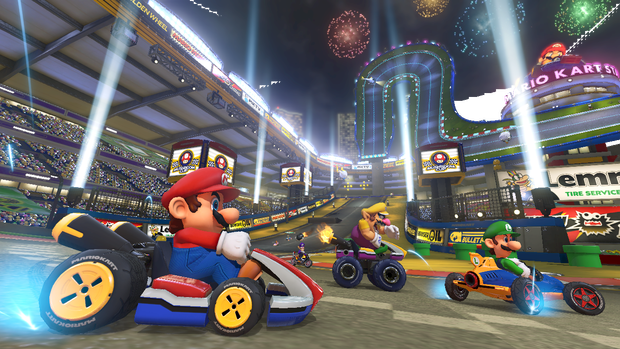
Luckily, for the majority of the time, players will be racing on their own or with a single co-op partner, and they’ll get to fully enjoy the extra detail that the Tokyo team have lovingly poured into Mario Kart 8. Wisely, the dual-player split-screen is vertical rather than horizontal, showing off as much of the game as possible.
Aside from the standard local multiplayer, your sofa sharing partner can also hop online with you to take on the unwashed masses. This is another much appreciated example of Nintendo’s commitment to local multiplayer, but let’s hope voice-chat makes it into the online mode this time, eh?
While the visual overhaul and network features are all interesting caveats, the major new addition to Mario Kart 8 is, of course, its anti-gravity component. The anti-grav sections are used relatively sparingly throughout the eight new tracks I got to experience, but they still added an interesting element to the gameplay. A lot of these sections seem to function as alternate path ways rather than the gravity-bending game-changers you may expect. They lend themselves well to shortcuts, but due to the static camera angles I rarely felt that I was actually breaking the laws of gravity or truly hanging from the ceiling of certain courses, which is a shame.
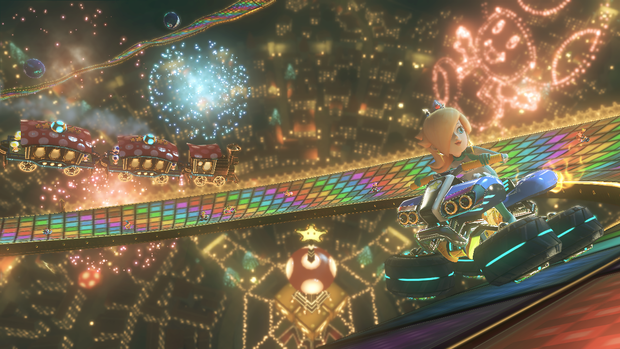
The exception to this was the underwater course: Water Park. The stylized course switches between on-land and fully submerged sections in a fun and well designed track, and uses cleverly disorienting backgrounds to add a palpable sense of height to the anti-grav sections. Having only seen half of the new courses I am intrigued to discover what else Nintendo have come up with, and hopefully the latter tracks will show more interesting uses of the anti-gravity. The thought of an upside down Rainbow Road makes my butt cheeks clench: do it, Nintendo.
Overall, the eight new tracks that were available are well designed and memorable, sporting very different aesthetics and layouts. Aside from the plain starting track of Mario Stadium, I can see many of these tracks becoming online favourites – especially the multi-layered Shy Guy Falls.
While the new courses look visually striking (the candy-filled Sweet Sweet Canyon, especially) the graphical improvement is most apparent in the remastered retro courses. Upon first booting up classic tracks like Moo Moo Meadows and Cheep Cheep Beach, the difference between the original and their HD counterparts is genuinely astounding. Gone are the bare-boned primary colours and simple models of the Wii courses, as now their backgrounds have been filled to the brim with gloriously rendered detail.
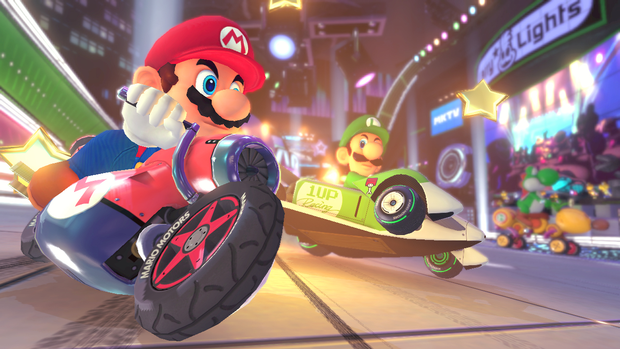
Moo Moo Meadow’s colours pop and shine in high definition, and the track’s previously sparse backgrounds are now bursting with intricately detailed barns, trucks, and signs sporting various spoof Mario products. The extra detail really brings new life to these courses, injecting them with more charm and character than they’ve ever possessed before, while somehow simultaneously invoking a powerful sense of nostalgia.
It’s not just enhanced backgrounds and prettier textures that have been worked into the retro courses, however. The much vaunted anti-grav features make an appearance in several tracks, adding a new layer of gameplay to series staples like Toad’s Turnpike. As well as the additional anti-gravity implementations, other small changes have been added to each map to help make the experience more fun. Take the aforementioned Toad’s Turnpike for example: the course’s meandering traffic is now more than just an annoying obstacle to avoid – certain trucks carry ramps that you can boost off of to give you a significant advantage. These thoughtful and subtle redesigns are perhaps the most impressive part of the game in my eyes, as they were completely unexpected and above and beyond the call of duty.
Aside from the anti-gravity sections, there has been one other major change to the formula: you can now only hold one item. As Mario Kart veterans will know, this simple change has much greater consequences than you might think. In previous games, you could keep one item as a shield, allowing you to defend yourself by holding an item like a banana behind you while you attacked with your front-held shell. Now, if you want to block attacks, you will have to do it at the cost of your one and only item, making using a shield a more tactical and punishing decision.
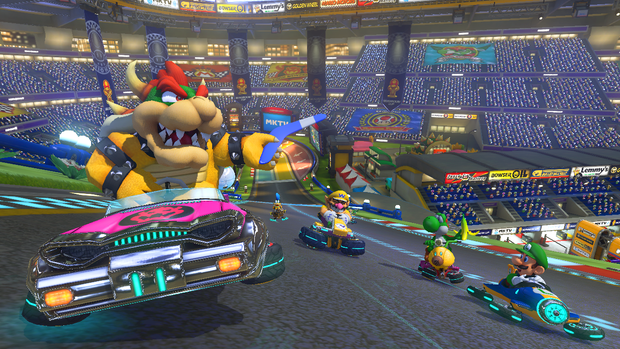
Speaking of items, there are also two brand spanking new weapons for you to punish your friends with: the self-explanatory boomerang and the close quarters Petey Piranha. The Petey Piranha lets you munch nearby players and also gives you a slight speed boost when used repeatedly. While not anything radically different, they are welcome additions nonetheless.
Taking a cue from the series’ 3DS outing, Mario Kart 8 looks to boast a well designed and varied selection of customisable karts – and the ones shown in this preview build were bursting with character. From the aptly named sports car inspired “Sports Coupe”, to the jet shaped “Mach” bike and, my personal favourite, the worm shaped “wild wiggle”, each kart looks and feels unique and memorable.
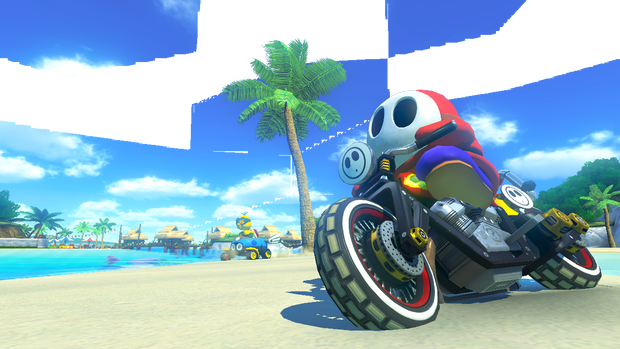
When Mario Kart 8 hits shelves at the end of May, it will be the console’s first major release since February’s Donkey Kong: Tropical Freeze. Yet for such a marquee Wii U title, the game seems to criminally underuse the console’s key selling point. While the GamePad use has improved since its sole function as the much maligned horn in earlier builds (there is now a map function and off-screen play) the intuitive controller’s most obvious use seems to be absent entirely in Mario Kart 8. Sonic Racing showed that three player kart racing worked wonders with one player using the GamePad screen and the other two on the TV, and yet, disappointingly, Mario Kart 8 chooses to forgo this entirely. This is perhaps the biggest oversight about this build of Mario Kart 8, as the extra screen space provided by having a player on the GamePad would be a great selling point for both the game and the system.
The build previewed here was made at the end of February, so I am hoping that the team at EAD Tokyo are using these few months to implement the GamePad screen into local multiplayer, as well as adding a bit of visual polish in the form of some much needed anti-aliasing. Otherwise, Mario Kart’s Wii U debut is a great-looking game (even with the occasional nasty jaggie) and, more importantly, is still a lot fun to play. Racing around the HD Koopa Kingdom gave me some of the best hours of gaming I’ve experienced in a while, and though the game may not reinvent the wheel or work wonders for Nintendo, when it’s this much fun it doesn’t really matter.
Preview based on time spent at Nintendo’s Windsor offices.


